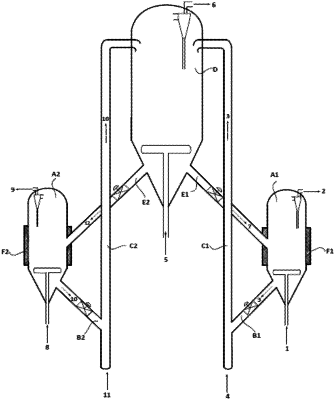| CPC C07C 5/333 (2013.01) [B01J 8/0055 (2013.01); B01J 8/1836 (2013.01); B01J 8/24 (2013.01); B01J 38/02 (2013.01); B01J 38/06 (2013.01); B01J 2208/00115 (2013.01); B01J 2208/00407 (2013.01); B01J 2208/00557 (2013.01)] | 18 Claims |

|
1. A process for production of light olefins by dehydrogenation of alkanes in a plurality of semi-continuously operated fluidized bed reactors Ai; (i=2, . . . n) provided with a common continuously operated catalyst regenerator (D), wherein the process comprises sequential steps:
a) feeding a hot regenerated catalyst and a pre-heated diluent stream to the plurality of semi-continuously operated fluidized bed reactors;
b) pre-treating the hot regenerated catalyst by feeding a reducing gas to the plurality of semi-continuously operated fluidized bed reactors to obtain a pre-treated catalyst;
c) feeding a pre-heated alkane feed to the plurality of semi-continuously operated fluidized bed reactors for catalytic dehydrogenation in presence of the pre-treated catalyst to obtain a product mixture comprising olefins, unreacted alkanes, product gases, and a spent catalyst;
d) separating the product mixture from the spent catalyst in reactor cyclones;
e) separating remaining hydrocarbon molecules from the spent catalyst by stripping using steam, or an inert gas and recovering stripping product gas through the reactor cyclones;
f) transferring the spent catalyst to the common continuously operated catalyst regenerator (D); and,
g) reactivating the spent catalyst in the common continuously operated catalyst regenerator by burning coke deposited on spent catalyst using air, oxygen, or an oxygen containing gas,
wherein the pre-heated diluent stream and the pre-heated alkane feed are in a molar ratio in a range of 0.1 to 5,
wherein the process in each of the plurality of semi-continuously operated fluidized bed reactors begins at a different time to maintain a constant catalyst inventory with time in the common continuously operated catalyst regenerator, and to maintain a minimum catalyst inventory in each of the plurality of semi-continuously operated fluidized bed reactors by flowing steam, or an inert gas at a minimum velocity during reactivation of the spent catalyst, wherein the process occurs in a sequence wherein a slide valve of a stand pipe opens at t=0 minutes to transfer the regenerated catalyst from the common continuously operated catalyst regenerator to the semi-continuously operated fluidized bed reactor Ai−1, and wherein a slide valve of a stand pipe Bi−1 remains closed at t=0 minutes until a desired catalyst inventory is built up in the semi-continuously operated fluidized bed reactor Ai−1,
the slide valve of the stand pipe Bi opens to transfer the spent catalyst from the semi-continuously operated fluidized bed reactor Ai to the common continuously operated catalyst regenerator through a lift line Ci, wherein after regeneration, a slide valve of a stand pipe Ei opens and the hot regenerated catalyst flows into the semi-continuously operated fluidized bed reactor Ai, and wherein at the same time, the spent catalyst from the semi-continuously operated fluidized bed reactor Ai+1 flows into the common continuously operated catalyst regenerator through a slide valve of a stand pipe Bi+1 and the lift line Ci+1, where i=2, . . . n.
|